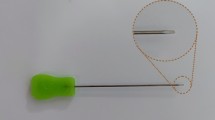Abstract
Purpose
Knowledge of anatomical landmark to pulley system of the thumb is essential in successful treatment of trigger thumb release either by percutaneous or by minimally invasive technique. Though surgical release of trigger thumb is done commonly, there is paucity of data in the literature regarding its surface landmarks. The purpose of this study is to identify palmar surface anatomical landmarks to the pulley system of the thumb.
Methods
Dissection was performed on 55 fresh frozen adult cadaveric thumbs. The palmar thumb creases were given names as the proximal–proximal crease (PPC) present at the metacarpophalangeal joint, the distal–proximal crease (DPC) over the middle of the proximal phalanx and the distal crease (DC) at interphalangeal joint. The distance between the proximal edges of each pulley to the three thumb creases and longitudinal length of A1, A2, oblique and Av pulley was measured using digital vernier caliper and was expressed in mean and standard deviation.
Results
The proximal edge of A1 pulley was 1.98 ± 1.61 mm proximal to the PPC. The mean longitudinal length of the A1 pulley was measured to be 5.06 ± 0.87 mm, so the distal edge of the A1 pulley was calculated to lie 3.08 mm distal to PPC. The proximal edge of Av and oblique pulley was situated 7.78 ± 2.5 and 15.72 ± 3.22 mm distal to PPC, respectively. The proximal edge of A2 pulley was very nearer and 2.88 ± 1.79 mm proximal to DC.
Conclusion
The knowledge of anatomical skin surface landmarks is helpful in the percutaneous release or minimally invasive procedure. The PPC serves as a definite landmark for A1, Av and oblique pulley whereas it is the DC for A2 pulley.





Similar content being viewed by others
References
Carrozzella J, Stern PJ, Von Kuster LC (1989) Transection of radial digital nerve of the thumb during trigger release. J Hand Surg Am 14:198–200
Cebesoy O, Karakurum G, Kose KC, Baltaci ET, Isik M (2007) Percutaneous release of the trigger thumb: is it safe, cheap and effective? Int Orthop 31:345–349
Chang EY, Chen KC, Chung CB (2015) MR imaging findings of trigger thumb. Skelet Radiol 44:1201–1207
Fiorini HJ, Santos JBG, Hirakawa CK, Sato ES, Faloppa F, Albertoni WM (2011) Anatomical study of the A1 pulley: length and location by means of cutaneous landmarks on the palmar surface. J Hand Surg Am 36:464–468
Hazani R, Elston J, Whitney RD, Redstone J, Chowdhry S, Wilhelmi BJ (2010) Safe treatment of trigger thumb with longitudinal anatomic landmarks. Eplasty 10:e57
Hazani R, Elston J, Wilhelmi BJ (2011) Transverse anatomic landmarks for the A1 pulley of the thumb. Hand 6:416–419
Jongjirasiri Y (2009) Length and landmark of A1 pulley in hand: an anatomical study. J Med Assoc Thai 92:41–46
Maneerit J, Sriworakun C, Budhraja N, Nagavajara P (2003) Trigger thumb: results of a prospective randomised study of percutaneous release with steroid injection versus steroid injection alone. J Hand Surg Br 28:586–589
Nikolaou VS, Malahias MA, Kaseta MK, Sourlas I, Babis GC (2017) Comparative clinical study of ultrasound-guided A1 pulley release vsopen surgical intervention in the treatment of trigger finger. World J Orthop 8:163–169
Pandey BK, Sharma S, Manandhar RR, Pradhan RL, Lakhey S, Rijal KP (2010) Percutaneous trigger finger release. Nepal Orthop Assoc J 1:14–18
Patel RM, Chilelli BJ, Ivy AD, Kalainov DM (2013) Hand surface landmarks and measurements in the treatment of trigger thumb. J Hand Surg Am 38:1166–1171
Ragoowansi R, Acornley A, Khoo CT (2005) Percutaneous trigger finger release: the ‘lift-cut’technique. Br J Plast Surg 58:817–821
Schubert MF, Shah VS, Craig CL, Zeller JL (2012) Varied anatomy of the thumb pulley system: implications for successful trigger thumb release. J Hand Surg Am 37:2278–2285
Wang J, Zhao JG, Liang CC (2013) Percutaneous release, open surgery, or corticosteroid injection, which is the best treatment method for trigger digits? Clin Orthop Relat Res 471:1879–1886
Wilhelmi BJ, Mowlavi A, Neumeister MW, Bueno R, Lee WP (2003) Safe treatment of trigger finger with longitudinal and transverse landmarks: an anatomic study of the border fingers for percutaneous release. Plastic Reconstr Surg 112:993–999
Acknowledgements
The authors would like to acknowledge those who had donated the bodies for scientific purpose through the body donation program.
Author information
Authors and Affiliations
Contributions
AK—project development. RV—project development, manuscript editing. DG—project development, data collection, data analysis, manuscript writing.
Corresponding author
Ethics declarations
Conflict of interest
The authors declare that they have no conflicts of interest.
Rights and permissions
About this article
Cite this article
Gnanasekaran, D., Veeramani, R. & Karuppusamy, A. Topographic anatomical landmarks for pulley system of the thumb. Surg Radiol Anat 40, 1007–1012 (2018). https://doi.org/10.1007/s00276-018-2029-x
Received:
Accepted:
Published:
Issue Date:
DOI: https://doi.org/10.1007/s00276-018-2029-x




